Most hickory nuts in the US are edible, the most popular one being the pecan, which has a limited range in the south. Here in central New England (and in much of the estern US), the most common hickories are the shagbark (Carya ovata) and pignut (Carya glabra). They are easy to find and gather, and as tasty as pecans. I think of them as the pecans of the north, though they do grow in the south, as well. They don’t get as much attention as pecans because the nutmeats are smaller and more difficult to shell. But once you get the hang of it, it’s well worth the effort. I’m going to describe how to identify, where to find, and how to harvest the nuts of shagbark hickory and pignut hickory, so that you, too, can forage for them. If you live in the eastern US, chances are good that you have at least one of them in your area.
Before I knew how to distinguish between the various types of hickory, I was eating both pignuts and shagbark hickory nuts. The latter are universally said to be sweet, but I eventually learned that most sources promote the pignut’s bad reputation, with reports of flavor ranging from bitter to bland. That has not been my experience at all. In fact, I’ve never had a bitter pignut. I find the flavor of nuts from the shagbark and the pignut to be comparable. Both are variable, usually flavorful, but never bitter.
Some sources describe another species of pignut, Carya ovalis, usually called sweet pignut or red pignut. The nuts of C. ovalis are said to be sweet, in comparison to the “bitter to bland” flavor of C. glabra. But I’ve examined the pignuts in my area and I’m pretty sure most are C. glabra. And the nuts are generally sweet. Perhaps some of them are hybrids….But I won’t go into that.
Have you tried pignuts? If you have, I’d love to hear what you thought of them, so consider this a formal invitation to leave a note in the comment section below this post!
Where to find shagbark and pignut hickory trees
The two species are often found together and each grows to about 90 feet, usually in mixed oak forests. In my area, hickory trees are also common along the roads, so I often forage along back roads. They tend to fruit well there, because they get a lot of sun exposure. According to the USDA plant profile, the shagbark hickory ranges over much of eastern North America. However, it’s uncommon in northern New England and Canada. Pignut hickory ranges over most of the eastern US, Texas, and Ontario.
Bark of shagbark and pignut hickory
The shagbark hickory’s immediately obvious distinguishing characteristic is its bark. It becomes quite shaggy when mature, and if you learn to recognize it, you can easily hone in on the tree. This is great to do in winter and spring, because it’s a lot easier to scan the woods for bark characteristics when they’re not obscured by leaves. If you do that, you’ll know where to look in the fall for nuts. However, you’ll miss some nuts that way, because younger shagbark trees that have not yet developed shaggy bark sometimes bear a lot of nuts. Check out the photos to see how the bark appearance changes as the tree ages.
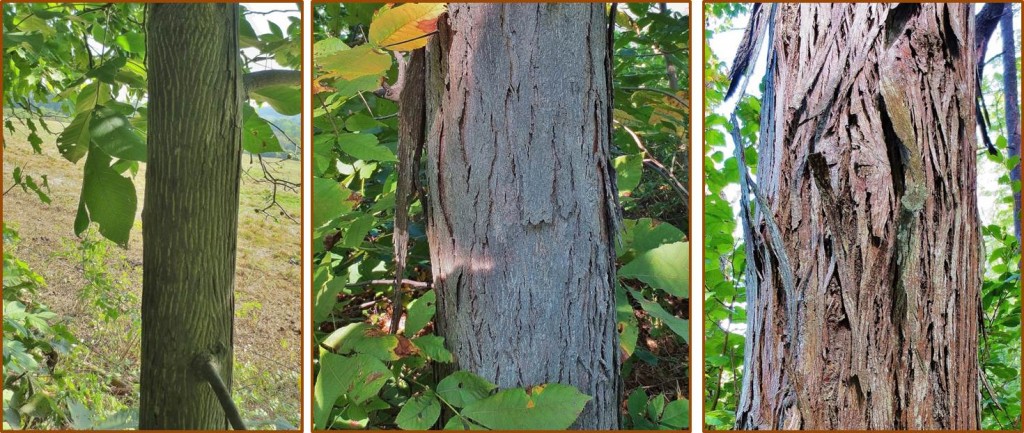
Bark of shagbark hickory trees, on (from left to right) 4 inch, 10 inch, and 16 inch diameter trunks. All three trees bore a lot of nuts.
The pignut has more variable and much less distinctive bark. Unless you’re really into the bark identification, it’s not the easiest way to find pignut trees. You’re probably better off looking for the leaves and nuts. If you’ve already found shagbarks, look around in the same woods for pignuts. They’re often found together.
Leaves of hickories
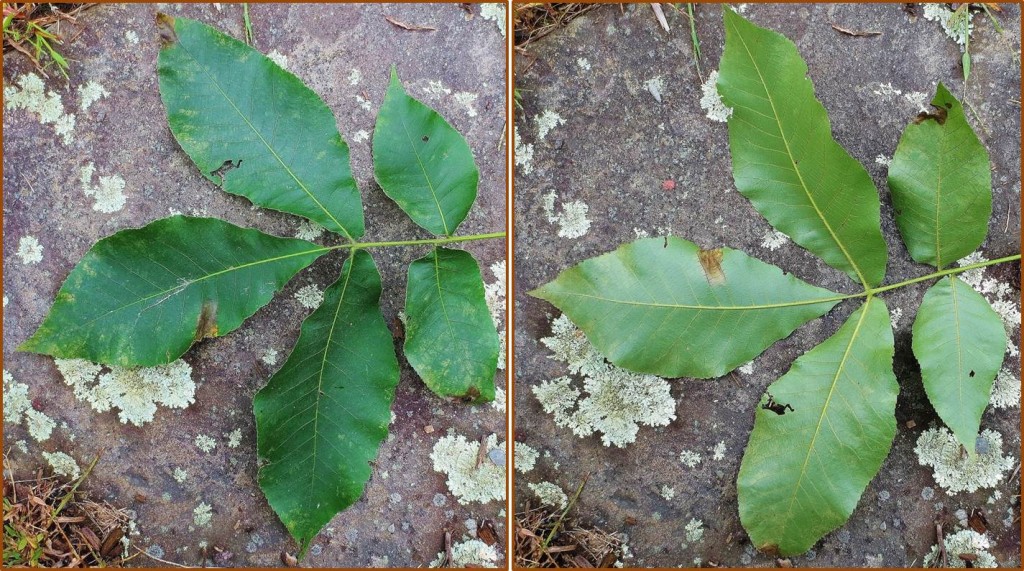
Compound leaves of shagbark hickory. Top on left, underside on right. Each leaf consists of 5 leaflets as shown (sometimes 7). Pignut hickory leaves are similar.
Leaves of shagbark and pignut hickories are very similar. They are alternately arranged on twigs. Each leaf consists of 5-7 leaflets (usually 5) as you can see in the photo. The three leaflets at the end of the leaf are noticeably larger than the others.
What hickory nuts look like
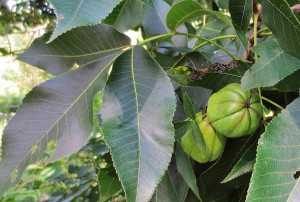
Shagbark hickory nuts usually grow singly or in pairs. This photo was taken in early August, when the nuts are large, but when husks are still fresh, green, and closed. They are not ready to pick.
When still in the husks, the nuts of shagbark and pignut hickory appear quite different from each other. The roundish shagbark hickory nuts appear much bigger (about 2 inches in diameter) because they have thick husks. The husks have ridges that make them look like tiny green pumpkins. As the husk dries, it usually opens into 4 sections. By the time they drop to the ground, some nuts will have partially open husks. I always find a few nuts with the husk totally removed, but I’m not sure if these opened naturally, or if an animal removed the husk and dropped the nut.

Shagbark hickory nuts. Shows how husk dries and opens. Sometimes, however, the husk remains mostly closed even after it dries.
Tear drop shaped pignuts have thin husks that appear smooth and green at first, but turn warty and brown as they dry. The husks sometimes open slightly into 4 sections as they dry, but often they don’t open at all, and rarely do they open enough to make removal of the nut easy.
Gathering hickory nuts
Here in Massachusetts, both pignut and shagbark hickory nuts are ready to harvest in early September, when they begin to fall to the ground. These trees are very common along my usual walking routes, so I always take a bag with me when I go out in early fall, and collect the nuts off the ground as I go. Most will still have their husks intact. You do not need to wait until they fall to the ground to harvest them; I pick the nuts from low hanging branches as I walk. But don’t be tempted to get a head start and pick them before the first ones have fallen. The nuts won’t be ripe.
When you gather hickory nuts, you will probably notice signs of other animals doing the same. Many other animals like them as much as we do, and you can see a few examples of rodent sign on hickory nuts here.
Removing hickory nut meats from the shell
Spread pignuts and shagbark hickory nuts (whether or not they have lost their husks) in the sun for 1-2 weeks before cracking them. The kernels will shrink from the walls of the shell as they dry, making removal from the shell easier. Most of the shagbark husks will open and the nut will be easy to remove. Crack the shells with a Good Cook Classic Nutcracker with Picks, a hammer, or a stone, and remove remaining pieces of nut meats with a sharp picker. If you gather a lot of hickory nuts and/or black walnuts, you might want a Kenkel Hardshell Nutcracker
. It gives you a lot of control, so you can gently crack the nut in different positions and remove much of the shell without shattering the nutmeat.

Shagbark hickory nut meats. It’s challenging to get large fragments, and some pieces have to be removed from the shell with a picker.
Even after drying, most pignut husks will remain closed, but because they are so thin, you do not need to remove them. If the husk does not come off easily, I crack the nut, husk and all, with a Hardshell Nutcracker. Then I remove remaining kernel fragments with a picker.
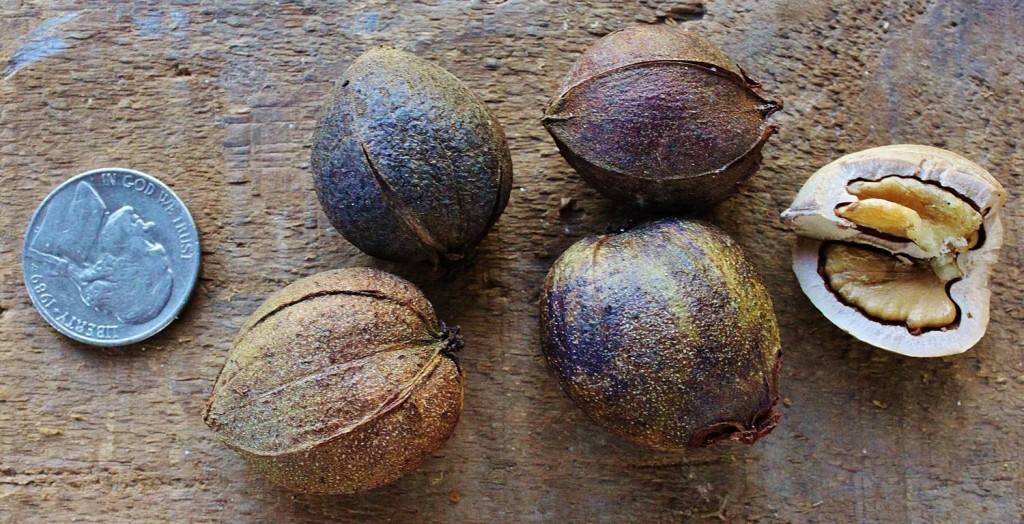
The dry, brown husks of these pignuts remain tightly attached. They fall off in pieces as you crack them.
There are some online videos that show how to crack hickory nuts with a stone or hammer in such a way that the kernel sometimes falls out in one piece or a few large pieces. There may be a knack to that. If so, I don’t seem able to get it, because usually I end up with a lot of tiny fragments. Overall, I find it quicker and easier to crack them with my Hardshell cracker, and I don’t have to worry about smashing my fingers.
Using hickory nuts
Use hickory nuts in any way you use other nuts. I eat the raw nuts alone as a snack, or sprinkle them on yogurt, oatmeal, and salads. They can be added to baked goods and used to make nut milk and nut butter. For a sumptuous treat, try my recipe for birch syrup ice cream with buttered hickory nuts
Shared on:
- HomeAcre Harvest Hop
- From the Farm Blog Hop #56
- Natural Living Link-Up #95
- Simply Natural Saturdays
- Homestead Barn Hop #135
- Backyard Farming Connection #57
- Tuesdays with a Twist #33











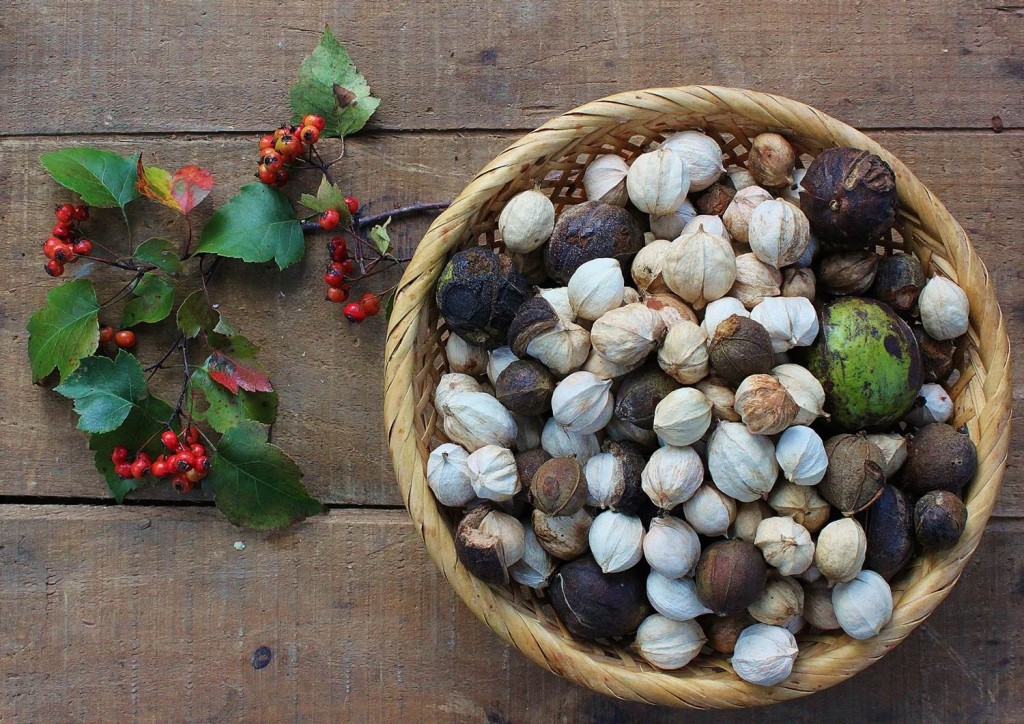
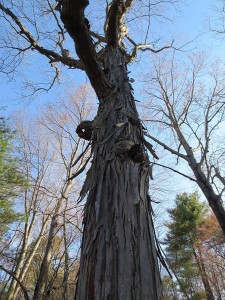
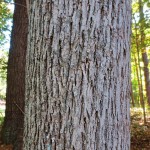
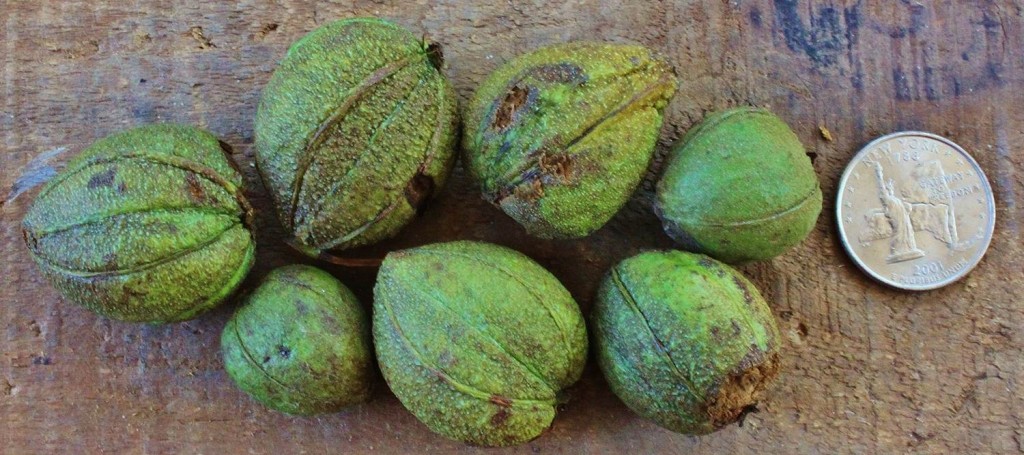

Pingback: Birch syrup ice cream with buttered hickory nuts - One Acre Farm
Thank you for this great post on hickory nuts. It was very timely for me. I only recently became interested in foraging when I realized that the huge green balls that dropped into our yard every fall were black walnuts. I then started paying more attention to things on the ground, and found a pignut hickory tree at my work. (took a while for this total newbie to figure out what they were!). So now I’ve started looking. Just found that the beautiful old cemetery down the street has at least a dozen full, mature old hickory. I picked up a couple of gallons in just a few minutes. Can’t find shagbark though, unfortunately. Tasted the pignut (not sure what Latin name variety it is, but looks like those in your picture) and they are sweet and lovely. I do have a question about sorting and storing. First of all, it hasn’t been sunny enough to lay out nuts to dry, and won’t the squirrels grab them? I left some dehusked walnuts in my driveway the other day, and they all disappeared! Secondly, does float testing for bad nuts work on hickories like it does on black walnuts? If so, should they be dried and dehusked, so floating only the hard nuts? I tried float testing some still in their husks, and two thirds floated! That seems like a high failure rate unless there was some problem with the particular tree. Any suggestions on storage? In the husk, in the shell, or already shelled? Thanks so much! I am going to order a hardshell nutcracker (Get Crackin one, I think) and can’t wait to start using some of this great nutmeat!
Hi Kim,
Sounds like you hit a pignut bonanza! Seems like most of the hickories did really well this year. Not sure where you are from, but there was a bumper crop both here and in the southeast this year. If you don’t have shagbark, you might have shellbark, depending on your location. There are 8-10 other species, too, depending on location.
As for pilfering rodents, yes they will quickly snatch the nuts if left on the ground, especially if left near trees in the same place for days at a time. To prevent that, spread nuts on top of something human made that is movable (I spread them on a screen set on a wheel barrow). Put it in an open area away from trees, bring it in at night (I wheel it into garage or breezeway), and back out during day. It helps to move wheel barrow a couple of times during day, too. Basically, rodents are wary of human made things that move around a lot and that are away from protective cover.
You have to husk them for floating test to be reliable. Husks themselves might float and air between husk and nuts will make good nuts float. I haven’t been bothering with floating test because the vast majority of my hickories are good.
You can store either in shell or out of shell. I store mine in the shell, in a closed container at room temperature. Shelled nuts can be stored for weeks to months in container at room temp, but for more than a few months, I would store shelled nuts in freezer.
Thanks for writing! Did I answer everything?
We live in Middle Tennessee and recently bought a house with a REALLY tall “nut tree” in the front yard. In doing some research, I have determined it is a pignut hickory tree. When are they ready to harvest?
Thanks for this very helpful information about hickory nuts! I’ve harvested shagbark hickory nuts several times over the years. Last week I was on a hike and discovered what looked like the same nuts, but the tree didn’t have the trademark shaggy bark. I surmised that it was a different variety of hickory, and you’ve helped me decide that it was a pignut hickory. I did harvest a nice bag of these nuts, and I’m in the process of cracking them. I am thinking of making them into a “pecan” pie!
Hi James! Glad it was helpful. One thought: if the nuts you found had thick husks, they could be nuts of mockernut hickory, Carya tomentosa. Those are also sweet and edible, bark is similar to pignut, but husks look more like those of shagbark hickory. (There are more than 10 species of hickory in North America, but I wrote only about the few species common in my immediate area, to avoid an unnecessarily complicated post). Good luck with your pie!
This is excellent info. I know we have hickory nuts on our land we just bought, but we have not gone foraging for them this season yet. Thanks for sharing with us at The HomeAcre Harvest Hop!
Please join us again Thursday for our regularly scheduled hop at:
http://summersacres.blogspot.com/2013/11/the-homeacre-hop-43.html
~Ann
I just wanted to stop by and let you know that your post will be featured at Thursday’s The HomeAcre Hop. I will also tweet,
facebook, and +1 your post. Please stop by and grab the featured button at:
http://summersacres.blogspot.com/2013/11/the-homeacre-hop-43.html
Congrats!
~Ann
Here in East Texas we have lots of black walnut and pignut hickories. One year, the kids and I decided to make a couple of hickory pies, in place of pecan pies, at Thanksgiving. After cracking and picking the nuts, we decided we must have been crazy to attempt that! Of course, the pies were delicious! But it is way too much work to get that much meat out all at one time.
Yeah, that’s why I invested in that expensive hardshell nutcracker. You have a lot of control when you crack the nut, so it’s easier to get bigger pieces of nut, and less picking to do thereafter. Still, it’s harder to get the nutmeat out of hickories than other nuts, so I hear you!
In order to get perfect Halves, put the nut on edge, not flat, tap with a hammer as you hold the nut on edge. Don’t smash, you will feel it start to give way and it will split into 2 halves that are easily removed for the meat. Been doing this for years.
Pingback: Foraging Ethic - One Acre Farm
Pingback: Kale Salad with Maple Vinaigrette - One Acre Farm
Hi! I’ve been reading your weblog for some time now and finally got the courage to go ahead and give you a shout out from Houston Tx!
Just wanted to mention keep up the excellent work!
Ha! I’m from Houston and am currently in East Texas. Found this wonderful website with this great information. I’m off to the woods to forage!
Thanks for the article! Found it very interesting and it verified what I believed to be true! Many folks have told me that pignut hickory nuts were a waste of time but I always found them to be quite delicious. I am planning on foraging for them this year and most hickory nuts on my farm are pignut. A few years ago my sister in law obtained some pignuts that her grandfather had shelled and frozen and decided to experiment. She made pies from them following a pecan pie recipe and she gave my wife one I think to get me to be a guinea pig. I was a pig alright. That was the best darn pie I have ever had to this day and I think it’s way past time for another. Yes I ate every bite. I would have shared with my wife but she said I could have it. Maybe I can get her to try the next one. Thanks again think I’ll go see if any are falling yet!!!!!
Great story, Chuck! I hope you find lots of pignuts. There are very few nuts in the trees here this year, but maybe you have lots where you are. Good luck, and I hope your 2nd pignut pie is as good as the first!
I live in northeast Texas and we have a pignut tree that is loaded with nuts. I have always been told that pignet are not for eating. Our Pecan cracking place will not crack or buy pignuts. Hate to see these nuts go to waste if they are good. Thanks
Just be careful – I have learned that some people call the bitternut (Carya cordiformis) a “pignut”. Bitternuts are extremely bitter, so you will know immediately if that is what you have by the flavor. If you do have true pignuts, though, they are edible.
We probably have ten hickory trees on our property. I’ve tried raking them in the autumn but the job is overwhelming! We can’t possibly use them all. It’s like walking on a carpet of marbles! Doesn’t seem much interest in our area in buying them. Any suggestions?
I would just leave them there for wildlife. Hickory nuts are a great favorite of hungry animals.
Hey jean where do u live? If its in massachusetts I’d come get some every yr.
+1 where do you live?
get a squirrel
I would love some if I could get to you? Where are you? I would totally love to have that problem!
I just found your site while looking up information on shagbark hickory trees. I live in Eastern MA and, after attending a foraging talk that helped me identify them, I went back and gathered a whole bunch. I like to be cautious, though, so while I am 99.5% sure I know what I have, my final question is, are there any dangerous look-alikes to shagbark hickories? I’ve looked through several books and websites, but haven’t seen any cautions. Thanks for posting and for the nutcracker tips.
Lisa, there aren’t really any “dangerous look alikes”, but I have no way of knowing if you’ve actually found hickory nuts, so I can’t tell you to eat what you have found. There is a bitternut hickory, Carya cordiformis, which tastes incredibly bitter and horrible (I have tasted one), but it won’t hurt you to taste a bit of one nut. You will not want to eat any more of it, so there is no danger, barring any sort of unusual sensitivity or allergy. Nonetheless, I highly recommend you get a couple of good books on tree identification to be certain you know what you are looking at. Robert Harmount Grave’s book, Illustrated Guide to Trees and Shrubs is excellent.
Thanks for the recommendation. I’ve requested it from the library. I’ve looked through several books and all confirm my findings, but I like to be thorough, so I’ll check that book out while the nuts are drying.
WE RECENTLY PURCHASED 8 ACRES OF LAND HERE IN THE FINGER LAKES, NY. THE LAND HAS ALOT OF TREES, SOME ARE SHAGBARK HICKORY, BUT THEY DON’T SEEM TO BE PRODUCING! WHAT DO YOU THINK IS WRONG? ONE OF MY THOUGHTS IS THE TREES ARE THICK AND MAYBE THEY ARE NOT GETTING ENOUGH SUN. ANY SUGGESTIONS APPRECIATED, BECAUSE WE WOULD LOVE TO HAVE THE TREES PRODUCE. THANKS.
It could well be that they don’t get enough sun, but it could also be that this is just a poor year. Hickories are like oaks in that respect – once in a while they produce prolifically, some years they produce modestly, and other years they produce very poorly. Last year was a banner year for hickories here in central MA, with tremendous nut production. This year, however, is the poorest I’ve seen in my 17 years of living here. So watch your trees for a few years to see what happens to production. You might consider thinning the trees in your woods, leaving the healthiest looking hickories standing. They will benefit from the reduced competition for sunlight.
Pingback: Episode 54: Fall Colors, Pignut Hickory & Acorns - Generations’ Bounty
Pingback: How to Start a Backyard Farm - One Acre Farm
I use a nail to get the meat out,
Weird, I know, lol. But it works.
Whatever works!
A horseshoe nail if you can get your hands on one works even better because it is more flat.
I have found the same thing as you regarding pig nuts and they tend to seem to have a thinner she’ll. In my area the shagbarks produce heavier usually biannual crops and a larger Nuts. I use a motorized drill cracker brand nut cracker I also use it for black walnuts as I usually harvest bushels of walnuts hickories and acorns every year thanks for the post.
Thanks for your message, Ray. That’s interesting that the pignuts have a thinner shell in your area. Maybe it’s a different subspecies of pignut. Ours have very thin husks, but the shell is just as thick and tough to crack as shagbark shells. I agree that these trees do not produce well every year, but good production in my area (Mass.) seems to be less than every other year. Take care!
I have sought these nut and beechnuts out as well for years. My father and grandfather used to take me walking in the woods in the early fall to gather as many as we could to share with the whole family, especially at Thanksgiving time. They are tasty and unique, and despite their small stature they are totally worth the effort put forth to extract the yummy meat hidden within. I hope this motivates you all to go out and give these hidden gems of the woods here in the northeast a try!!
Thanks for your comment, Don. I agree!
I have several Shag bark Hickories on my property. But I have one that has elongated nuts rather than round nuts,Could this be a shell bark?
Yes, it could be, especially if you are in the midwestern US. Shellbark hickory has a rather limited range in the midwest.
Can I dry the nuts with the husks on in a dehydrator?
I suppose you could use a dehydrator to hasten husk removal from shagbark nuts, though I’m not sure about shellbark. I know that pignut husks tend to remain adhered even after drying, and I have no experience with shellbark. If you try a dehydrator, I would remove and discard the husks when dry enough, and continue to dry the nuts in their shells for longer. If they aren’t sufficiently dry, they will spoil. I also don’t know how long and at what temperature they should remain in the dehydrator. And plain old sunshine does such a good job with this that I maay never find out.
Pingback: Nut Identification Help - Homesteading Today
Hi. I have a question you may have answered already and I missed it, but do you know why hickory trees produce more one year than another. I have several pignuts on my property where I’ve lived for two years now. The first season we had a ton of nuts. Great flavor and the chickens went nuts 🙂 over them. Our kids would just smash them on a rock and the chickens were able to pick them clean. The shells probably helped with their gullets too.
Last year, there was only a fraction of the nuts as the first year. I’m noticing this year that the squirrels are eating something off the hickory trees outside my office, which are just starting to fruit. Maybe squirrels are the culprits? Or do hickory trees just have a cycle?
What do you think?
Thanks,
Jon
Hi Jon, the theory is that the tree evolved to produce well only on (approximately) alternate years to maximize reproductive success. If they produced about the same number of nuts each year, the squirrel population would remain steady and they would eat most of the nuts, leaving few to germinate and grow into new trees. But if nut production is poor periodically, the squirrel population will crash when production is poor. Then the following year, when the tree produces well, the squirrel population will be low and many of the nuts will survive to germinate. This is why the trees are synchronized. In a given region, virtually all hickories will produce well on a “good” year, and poorly in a “bad” year. Oak trees use the same strategy with acorn production.
Much Good information. Growing up in Western Kentucky fall harvesting of shagbark nuts produced nuts for our mother’s Thanksgiving “Hickory nut pie” and at Christmas, a “Hickory nut cake”. Both were wonderful and the tradition has continued somewhat but just very special occasions. e.g. My sister provided one as a part of the treats at one of my granddaughters’ wedding. Fabulous dishes for those with with the grit to do the work of cracking the nut and picking the nut meat but well worth the effort.
Sounds like you’ve got some wonderful memories associated with hickory nuts, Don. So do I. I think my favorite is when my kids were young, and just discovering those wild, delicious nuts with fascination. I hope you continue to enjoy them. They are delicious!
so i have a pignut tree in my yard that i just identified as such. it is getting cut down in a few days since it is making moves on the garage and can’t stay. i just collected my second batch of nuts, all of the first batch were rotteded and likely from prior years. they all failed the float test.
this second batch is a ton of green ones off the ground and a few split brown ones. the brown ones float w/ the husk removed and are rotten so may still be from years passed despite my attempts to clean the yard. the green ones still in the husk sink. will they dry out into nuts worth eating or are they still too young?
if they will dry and ripen, can i pick the remaining green ones off the tree? the tree snapped in half without dying, so the top half is alive but at chest height, upside down, making harvest trivial!
Growing up in Warwick, NY foraging for hickory nuts was an annual fall event and we enjoyed cracking those nuts all winter long – so yummy. As to drying, we would simply put the nuts into a mesh bag (usually a large onion bag as we lived near Pine Island – a major onion producing area) and string the bags up in the garage rafters. We only picked up the nuts that were out of the hulls. Leave them hanging in open air to dry where rodents can’t reach them and once dried (I’m thinking we waited a month or so) enjoy!
When I moved to Manassas, VA I discoverd a Hickory tree on the Manassas battlefield that had the largest and most perfectly formed nuts I’ve ever seen. So excited, I raced home to enjoy my bounty. After cracking that gorgeous nut and happily chomping on it I quickly spit it out. Most bitter, nasty nut I’ve ever eaten. I asked my Dad about it and he said it was a pignut hickory. So yes, apparently there is a very bitter variety of pignut hickory out there.
On my farm in central Illinois, I have several hickory species. I only bother collecting shagbark and shellbark because there are few shellbarks and they have fewer nuts. Taste the same but shellbark is bigger. I haven’t tried it but have heard that putting the nuts in the freezer makes them easier to shell. I use the method of turning the nut on the thin side and wacking it with a hammer. Most come out in two unbroken halves this way.
Thanks for this. We also have lots of shagbarks here in central Mass but I’d long ago gave up on using the nuts because they’re so hard to shell. I’ll try drying them first. When the large outer husk separates I have tons of them all over the lawn. I rake them up and use as mulch around the hostas.
Pingback: Foraging for Vegans: 15 Wild Proteins
I have found what I think is a pignut Hickory tree. It is producing quarter sized nuts and they are dropping from the tree. It is the first week in July here in NC. Can I harvest them for eating. Everyone I talk to says it is to early for them. There are hundreds of them and id hate to let them go to waste. Thanks
GET A SQUIRREL
Thank you for this wonderful information. We recently moved to West Virginia on 15.5 acres. We are loaded with pignuts and black walnut trees. I am super excited to start foraging in the next few weeks. Your article was most helpful.
Hi Janet, I live in Rochester, N.Y. and in the last year or two have become reunited with hickory nuts. I used to pick them up for my mom years ago but had forgotten all about them. I had asked everyone I knew if they knew where I could find a hickory nut tree with no luck. But recently have been walking in our huge cemetery here and have found a hickory nut haven. I still have yet to determine what kind they are but I am guessing that most of them may be pignut because the majority seem to be tear shaped. However, it is the first week in September and there seem to be alot of them on the ground. The ones I remember picking up when I was a kid seemed to be open already and none of these are. At this point, will the ones still in the green husks mature and dry to an edible nut or are they no good and also as long as so many are falling unopened, is it safe to pick what I can reach on the trees an assume they are good. many that I have opened up are no good but others seem to have a meat in them but it is very soft.
My yard is littered with pig nuts mostly open nuts scattered by the squirrels who seem to waste so much. Back breaking to try to clean up. Do these remains hurt the lawn or help? This is a new lawn only one year old
We just moved in to a house built in a hickory forest. Needless to say I’m delighted, other than when they wake me up by falling on my roof! Do you know how long they are safe to eat on the ground or after a rain? I don’t want to eat any rotten ones!
Came across a pignut tree and I haven’t seen one since I was a kid. The nuts were on the ground and I wasn’t sure so I Googled pig nuts. I don’t want to explain what popped up. Then I Googled pig nut tree and came across your article. It was very informative and I thank you for putting it up. I filled my pockets and will dry them in the sun although I picked them up in a sunny spot. Thanks again
Pingback: Hickory nut harvest is underway! | Curious By Nature
Hi,I just harvested a bunch and I’m trying my hand at acorns too for acorn flour (my daughter makes a lot of macarons) I tried one and the mouth feel was rather “sticky”?? And it was a little bitter. They look like pig nuts but my bark is really shaggy…ideas?
Thank you for the info! I just discovered after living at our home for 3 years that we have a few Pignut Hickories on our property. One my husband wanted to remove until we discovered the nuts this year. We won’t be removing this one now! It has tons of fruit little did I know that they were edible. Thank you for helping me to identify them! To me they taste similar to a walnut but they are much sweeter! Maybe the sweetness comes from being free. 🙂
Hi. The home in PA that we just moved to has Hickory and black walnut trees. I just started picking the nuts up this past week. Mine look different from yours. The hickory trees are not very mature (about 6-8″) and they have a thin husk which strips off easily. The shells are thick and the nut meat small but tasty.
When I was at Gettysburg battlefield yesterday there was a shagbark tree on the confederate side. It has a thick husk (1/4″) that was self shedding. They are also hard shellled but with a bigger meat.
I found the best way to crack them was using a hammer with light tapping blows (learned it from a u-tube video).
I haven’t tackled the black walnuts yet; just driving over them in the driveway.
Also, I have seen posts that say to put them in water and those that float are bad (hole, cracks or bugs) and those that sink are good. Well, about half did float. I’m still going to open some and see. And what do you know about roasting them? In shell or out?
I have a shagbark hickory that left the dried husk on the tree, then opened and dropped the nuts out. Some of the nuts you can see are still in the dried opened husk on the tree but didn’t open enough to let the nut drop to the ground. I need to go to the back field where the pignut is and try those nuts.
Thank you so much for this great article. It helped me identify the two types of nuts from trees in and near our yard. I have been reading and searching off and on for a couple of years, trying to name these nuts. Your article helped me realize that our nuts are falling from two different trees which explains their difference in size. I had been assuming the nuts had come from the same tree, but now I know to look for a shag bark as the source for the larger nuts. Our yard is bordered by forest, so more than likely the nuts which are on that side are really coming from a tree in the forest which I have not noticed. Tomorrow, I hope to find that tree. Thank you again.
Ive heard that bitternuts can be made edible by roasting or something but haven’t been able to
find any information on that anywhere
Love your website ‘One Acre Farm’! It is very informative for people like me pursuing natural things. I found a pignut hickory yesterday as I was taking pictures of a scraggly blackjack oak to put on my website ‘chasingtrees.net’. It was very inconspicuous, and I’m sure I would not have found it if I was looking for one. When I feature the pignut hickory on my site, I will probably mention your site, as it has such good information. Thanks!
I see several other folks have asked this question, but I don’t see a reply: do the nuts that fall to the ground, still in their bright green husks, eventually become edible? We’ve had a big storm (Hurricane Florence!) so I collected lots of fallen nuts, almost all of which still have completely green husks. Is it worth collecting more or have they fallen too early and will not mature to an edible treat? Thanks!
i have never had a pignut not be bitter, so bitter that you can’t at them
Yes me and the kids found out today the incredible reziblanc to walnut but moister thou littler they are worth the attition southern Indiana oct
I have lived on this property 64 years. The big hickory tree on the hill above my house in what used to be our pasture was a big ol’ tree when I was 4 and it’s still producing today. The problem I have is getting to the nuts before the squirrels do. When I was little we had a collie dog that loved to find the nuts. She cracked them until she got to the meat. That tree is a treasure to me
We have lots of what we have always called the pig hickory. They produce prolifically so I thought maybe I would taste one. Well they are the bitter nut variety. Oh what an awful taste. Nothing eats them. Even the squirrels won’t touch them. I do have a couple shagbark hickorys that produced decently this year. I beat the squirrels to a goodly number now I just have to crack them. Not sure what the true pignut looks like but from your pictures it looks very much like the bitternuts in my woods.
Yes, since writing this post several years ago, I have learned that the nuts of bitternut hickory look very similar to pignuts. That may be the source of the confusion in the literature. Authors who described pignuts as bitter had probably misidentified bitternut as pignut. Bitternut hickory has leaves with smaller leaflets, and usually 9 leaflets instead of 5-7. I just hadn’t had experience with bitternut since that is not a common tree in my area.
It was very good to read your blog and from your comments I have learned much. I have been nursing a hickory tree next to my house for five years with hopes that it will supply us with good nuts one day. I just read a blog about bitternut hickory. You said that they have nine leaves instead Five or seven. I just counted the leaves on my trees and there are definitely nine on each branch. Although I am very disappointed that my hopes of having a harvest in my yard have been dashed, at least I won’t spend the next seven years waiting for it to bear bitter fruit that I cannot eat.
Fortunately, I live in the mountains in southern Oklahoma off grid and forage a large part of my food from the mountains. We have a lot of both Pignut and Shagbark all over the mountains and we enjoy them year round. Thank you For the information.
Pingback: What Are Hickory Nuts and Are They Nutritious? | Nutrition Advance
Great article. Here in central MA, we live in an oak-hickory-maple forest. We gladly pick up the shagbark nuts and invested in a beefy nutcracker that makes it simple to open and gives reasonable chance to extract intact nut halves. I sort to remove nuts with worm exit holes, wash the remaining nuts to separate floaters from non-floaters. I like to leave them for a few months to dry, though fresh ones generally taste oK that seem to stick to the inside of the shell more. I open floaters first with low expectations, but am often surprised with a good nut. I am still opening hickory nuts that we gleaned last year and so these nuts have great storage characteristics.
We also have very ‘bitter’ nuts with a thinner casing, more rounded than shagbark. They taste astringent, much like a raw acorn or an unripe persimmon. I assume these are bitternuts, or maybe a regional pignut. We will avoid picking these up next year, unless I hear of an easy way to leach the bitterness.
What I do is take the empty hickory shells (oncce the nut has been removed) and boil for an hour, covered. It makes a kind of tea/coffee beverage with a hint of maple that is tasty and has some nutrition. I had read about this in a Native American recipe book.
Hi Ken, I’m glad you are making use of your hickories. The bitter nuts with thinner husks are likely bitternut. You may be able to tell by the bark if you search for images online. If not, you should be able to tell next year when the trees leaf out.
Any chance of a recipe for hickory nut butter? The only one I’m seeing seems to be for boiling the hickory nuts and taking the oil out, not blending up the nuts like I would expect to make a nut butter (like you would with more conventional nuts).
Have several types of Hickory Many of the bitternut variety (we were told they were pig hickory, several of the shagbark and one I have not identified yet. It has the same style nut husk as the Shagbark but is much larger and fewer nuts on the tree. I beat the squirrels to them this year.
Our pignut hickory nuts are VERY bitter!! We are on the eastern shore of Maryland.
Then they are likely bitternut hickory, not pignut. It is a different species with similar looking nuts but the nuts are very bitter.
Hi. Was interested in germinating these pignut nuts. Which way does the nut sit in the soil when planting?
thank you for your wonderfully detailed article.
got a pignut hickory all the way up here in East Thetford Vermont.
do you know or have any resources about propagating this wonderful nut tree?